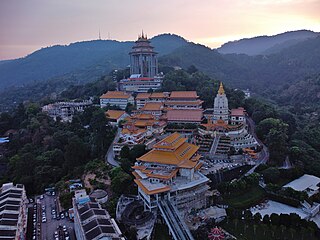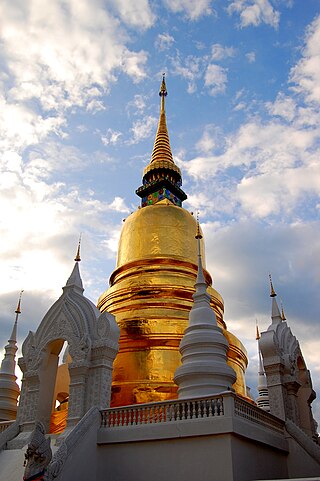
The Kek Lok Si Temple is a Buddhist temple within the city of George Town in the Malaysian state of Penang. Located at Ayer Itam, it is the largest Buddhist temple in Malaysia and an important pilgrimage centre for Buddhists from Hong Kong, the Philippines, Singapore and other parts of Southeast Asia. The entire complex of temples was built over a period from 1890 to 1930, an inspirational initiative of Beow Lean, the abbot. The main feature of the complex is the seven-story Ten Thousand Buddhas Pagoda commissioned by the late Thai king Rama VI, featuring 10,000 alabaster and bronze statues of Buddha and the 36.57-metre-tall (120 ft) bronze statue of Guanyin, the Goddess of Mercy. The 10,000 Buddhas concept belongs to the Chinese Mahāyāna school of Buddhism while Rama VI was king over a Theravāda country and Buddhist tradition.

Wat Chayamangkalaram, also known as the Chayamangkalaram Buddhist Temple, is a Theravada Buddhist temple within George Town in the Malaysian state of Penang. Situated at Lorong Burma opposite the Dhammikarama Burmese Temple, it is the oldest Siamese temple in the state. Wat Chayamangkalaram becomes a focal point for the annual Songkran, Loy Krathong and Vesak Day festivities within the city.

The Mahamuni Buddha Temple is a Buddhist temple and major pilgrimage site, located southwest of Mandalay, Myanmar (Burma). The Mahamuni Image is enshrined in this temple, and originally came from Arakan. It is highly venerated in Burma and central to many people's lives, as it is seen as an expression of representing the Buddha's life.

Kathina is a Buddhist festival which comes at the end of Vassa, the three-month rainy season retreat for Theravada Buddhists in Bangladesh, Cambodia, Laos, Malaysia, Myanmar, Singapore, Sri Lanka, India, Thailand, and Vietnam. The season during which a monastery may hold Kathina is one month long, beginning after the full moon of the eleventh month in the Lunar calendar.

The Arulmigu Sri Mahamariamman Temple is a Hindu temple within George Town in the Malaysian state of Penang. The oldest Hindu temple in the state, it was built in 1833, and features sculptures of gods and goddesses over its main entrance and facade.

Wat Bowaniwet Wihan Ratchaworawihan is a major Buddhist temple (wat) in Phra Nakhon district, Bangkok, Thailand. Being the residence of Nyanasamvara Suvaddhana, the late Supreme Patriarch of Thailand, it is the final resting place of two former kings of Chakri Dynasty: King Vajiravudh and King Bhumibol Adulyadej. The temple was established in 1824 by Mahasakti Pol Sep, viceroy during the reign of King Rama III.

Ganesha is a prominent Hindu god. He is the god of beginnings, wisdom and luck and worshipped as the remover of obstacles. Ganesha is easily recognized from his elephant head. Devotion to Ganesha is widely diffused and extends to Jains and Buddhists and beyond India.

The Malaysian Siamese are an ethnicity or community who principally resides in Peninsular Malaysia which is a relatively homogeneous cultural region to Southern Burma and Southern Thailand but was separated by the Anglo-Siamese Treaty of 1909 between the United Kingdom and the Kingdom of Siam. The treaty established the modern Malaysia-Thailand Border which starts from Golok River in Kelantan and ends at Padang Besar in Perlis. Before this, there was a mass migration of Siamese from Nakhon Si Thammarat to the northern Malay states seeking refuge following a civil war waged by Taksin of Thonburi against Nakhon ruler Nu in 1769.

The Burmese Buddhist Temple is the oldest Theravada institution and the only Burmese Buddhist temple of its kind in Singapore. Founded in 1875, the temple moved from its original Kinta Road premises to Tai Gin Road off Ah Hood Road in Novena in 1988. The temple houses the largest pure white marble statue of the Buddha outside Myanmar, and has become a religious landmark for Burmese and Singaporean devotees to make merit and take part in merit-sharing activities alike.
Thekchen Choling is a registered charity Buddhist organisation in the Republic of Singapore. The organisation was started in 2001 by Singha Thekchen Rinpoche and a group of his initial disciples. The organisation promotes non-sectarian Buddhism, emphasizing understanding of Theravada and Mahayana teachings. TCCL is committed to the Rime (non-sectarian) movement within Tibetan Buddhism though it is of the Gelug tradition. The primary practices and teachings of this temple are from Guru Rinpoche lineage and Lama Tsongkapa lineage.

Wat Chetawan is a Thai temple in Petaling District, Selangor, Malaysia. The temple is situated at Jalan Pantai, off Jalan Gasing in Petaling Jaya. It was built in 1957 and officiated by the late King Bhumibol Adulyadej, the King of Thailand at the time. The temple is also the only Malaysian Siamese temple which has been chosen as the custodian of the Buddha sacred relics for all Malaysian Buddhists that are parts of the ancient relics discovered in Piprahwa, a village in Uttar Pradesh near the border of the Kingdom of Nepal in 1898 which were presented to King Chulalongkorn of Siam by the then British Viceroy of India, Lord Curzon.

Wat Photivihan or Wat Yamu, is a Thai temple in Tumpat District, Kelantan, Malaysia. It is one of 25 temples found in Tumpat and is one of the most popular in the country.

Dhammikarama Burmese Temple is a Theravada Buddhist temple within George Town in the Malaysian state of Penang. Situated at Lorong Burma opposite Wat Chayamangkalaram, it is the only Burmese temple in the state, and a focal point for the annual Water, Thingyan and Mid-Autumn festivals in the city, as well as the Buddhist Lent.

A wat is a type of Buddhist and Hindu temple in Cambodia, Laos, East Shan State, Yunnan, the Southern Province of Sri Lanka, and Thailand.
Palelai Buddhist Temple is a Buddhist temple located in Bedok, Singapore. It was founded in 1963 by Phrakhru Prakassa Dhammakhun.

Wat Suan Dok, also known as Wat Buppharam is a Buddhist temple (Wat) in Chiang Mai, northern Thailand. It is a Royal Temple of the Third Class. The temple is on Suthep Road, approximately one kilometre west of Suan Dok gate at the west side of the moat.

The Sri Lankaramaya Buddhist Temple is located at St. Michael's Road in Bendemeer, Singapore. The temple is the primary Sri Lanka Buddhist temple of its kind in Singapore. It is one of the Theravada Buddhist temples in Singapore which is founded years back from Buddhist monks from Sri Lanka. It is operated by the Singapore Sinhala Buddhist Association which was established in 1920.

The Arulmigu Balathandayuthapani Temple, also known as the Waterfall Hilltop Temple, is a Hindu temple within George Town in the Malaysian state of Penang. Dedicated to Lord Murugan, the hilltop temple, with its seven-storey 21.6 m-tall gopuram, has been touted as the largest Lord Murugan temple outside India. It is sited comparatively higher above ground than Batu Caves, with devotees having to climb over 500 steps to access the place of worship.

Wat Phra Mahathat Woramahawihan is the main Buddhist temple (wat) of Nakhon Si Thammarat Province in southern Thailand. The main stupa of the temple, Phra Borommathat Chedi, was built by King Sri Dhammasokaraja in the early-13th century CE to establish a symbol for the Theravada Buddhism sect in the province. The temple is believed to house a tooth of Gautama Buddha.

Mahindarama Buddhist Temple is a Theravada Buddhist temple within George Town in the Malaysian state of Penang. The only Sri Lankan temple in the state, it is also one of the select few in Malaysia that houses the relics of the Buddha. The temple becomes a focal point for the annual Vesak Day festivities within the city.






















